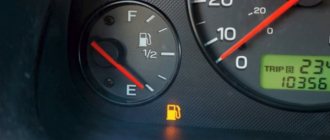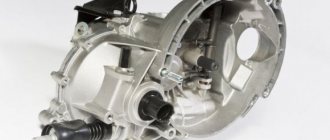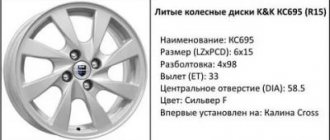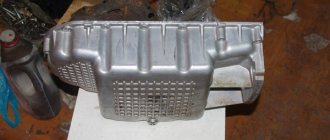Rated fuel consumption is one of the most informative and important characteristics of a car for the driver. This is what manufacturers often use to advertise and promote a particular new car model.
Among owners of used cars, it is considered acceptable to consume up to 10 liters of gasoline or diesel per 100 kilometers. In foreign countries, this indicator is indicated in miles, so recalculation into “native” units is often necessary. The fuel consumption tables available in this section of the site are considered very useful.
What does the fuel consumption indicator indicate? What does this characteristic mean? We are talking about hydrocarbon fuel consumption. For example, for an SUV the figure corresponds to 9.5 liters per 100 km. It is quite acceptable, primarily due to the weight and power of the car. The indicator can be reduced due to the following:
- use of energy recovery systems during braking;
- lightening the weight of the car when replacing body and chassis elements with innovative materials;
- engine improvements;
- replacing the exhaust system.
For new models, consumption of 6 l/100 km is considered quite a “cruising” figure, but it will be higher for heavy SUVs and pickups and lower for small hybrids. The necessary information can be found in the tables provided.
What to do if fuel consumption is higher than rated? If the car consumes more fuel and does not correspond to the nominal value indicated in the table, this means there is a malfunction. Experienced service center technicians will tell you how serious it is and how it can be eliminated. In some cases, tuning makes it possible to further optimize fuel consumption, but this is usually achieved by lightening the body structure or by replacing the engine. Professional automotive technicians can provide specific recommendations.
Fuel consumption of Lada Kalina ranges from 6.7 to 7.8 liters per 100 km.
Lada Kalina is available with the following types of fuel: Gasoline AI-95.
Fuel consumption Lada Kalina 2013, station wagon, 2nd generation
| Engine capacity | Power | Transmission | Drive unit | Fuel | Consumption |
| 1.6 l | 106 hp | robot | front-wheel drive | Gasoline AI-95 | 6,7 |
| 1.6 l | 106 hp | Manual transmission | front-wheel drive | Gasoline AI-95 | 6,7 |
| 1.6 l | 87 hp | Manual transmission | front-wheel drive | Gasoline AI-95 | 7,0 |
| 1.6 l | 98 hp | Automatic transmission | front-wheel drive | Gasoline AI-95 | 7,6 |
| 1.6 l | 87 hp | Automatic transmission | front-wheel drive | Gasoline AI-95 | 7,7 |
Second generation
Since 2013, the Lada Kalina car line has been updated and new cars have entered the market. Among them was not the usual sedan, with which the series began production, but the production of 5-door hatchbacks and station wagons continued. Fuel consumption on the new Lada Kalina has been reduced, but the manufacturer's requests do not always correspond to customer reviews.
The second Kalina came with two types of engines, each with a volume of 1.6 liters, but their power differed. There was also a choice of transmission options; as before, it was possible to purchase a car with a manual 5-speed gearbox or with a 4-speed automatic. A new feature was the entry into the arena of a 5-speed robotic transmission.
The power units installed on the Lada Kalina 2 had the following fuel consumption:
- VAZ-21126 - 98-horsepower engine, 1.6 liter capacity. with four cylinders and 16 valves, it was equipped with a distributed fuel injection system. Gasoline consumption figures in the city are 9.9 liters, on the highway 6.5 liters.
- VAZ-21127 - had 106 hp at its disposal. And fuel consumption on a free road was 5.8 liters, in urban driving it was 8.4 liters. Gasoline was also supplied by distributed injection.
Owners about consumption on Kalina 2
- Peter, Tyumen. I bought a Lada Kalina Cross in 2015. This is one of the few representatives of the domestic automobile industry with horsepower exceeding one hundred. And indeed the car turned out to be lively; my hatchback can compete with some foreign cars when driving on open sections of the road. The other side of the coin is gasoline consumption in the city; I did not observe the promised 8.4 liters both during the run-in and after it. This engine consumes at least 10 liters per 100 km of road with traffic jams.
- Lev, Voronezh. My wife does not know how to use a manual transmission, so I had to buy a car with an automatic transmission system. The choice fell on the second generation Lada Kalina 2014. Naturally, I understood that, as with any automatic, fuel consumption would be higher than with a manual, and that’s what happened. My figures in the city, judging by the on-board computer data, are usually within the range of 11-12.5 liters per 100 km of traffic. This sad moment worsened three years after the purchase, the injector with nozzles became clogged, for some reason this happens more often on the 8-valve Kalina than on other engines.
- Taras. Moscow. I never regretted buying Kalina Cross for my baby; she often helped me out in situations when more expensive foreign cars failed. And when breakdowns happened, and this happens, the repairs did not cost me much at all. Of course, it cannot be considered a plus that the Lada Kalina has fuel consumption per 100 km, with a power of 106 hp. higher than foreign cars of the same class. In my case, in the city, I fill at the rate of 12 liters, but on the highway the situation changes dramatically and costs drop to 7.5 liters.
- Ilya, Odessa. For a car with such a price, many disadvantages are forgiven, but they exist. First of all, this is the fuel consumption of the Kalina; it can sometimes be compared with the performance of some SUVs. Regular failure of components and parts is also somewhat annoying, but the main thing for me is road noise. Compared to foreign cars, you feel as if you are driving without doors. Of course, there are also advantages: it is inexpensive to service and parts are always easily accessible.
- Andrey, Nakhabino. I don’t understand why people have so much hatred for the Lada Kalina, because you can find out everything about it before buying, and there are plenty of disadvantages, but there are also advantages. Mostly they complain about high gasoline consumption, but you can always install LPG and save money. The metal on the body is good and thick, its quality cannot be compared with Chinese tins. It’s just a pity that the quality of the factory paint is rather weak, and over the years bubbles appear in some places.
Fuel consumption Lada Kalina 2013, hatchback 5 doors, 2nd generation
| Engine capacity | Power | Transmission | Drive unit | Fuel | Consumption |
| 1.6 l | 106 hp | robot | front-wheel drive | Gasoline AI-95 | 6,7 |
| 1.6 l | 106 hp | Manual transmission | front-wheel drive | Gasoline AI-95 | 6,7 |
| 1.6 l | 87 hp | Manual transmission | front-wheel drive | Gasoline AI-95 | 7,0 |
| 1.6 l | 82 hp | Manual transmission | front-wheel drive | Gasoline AI-95 | 7,0 |
| 1.6 l | 98 hp | Automatic transmission | front-wheel drive | Gasoline AI-95 | 7,6 |
| 1.6 l | 87 hp | Automatic transmission | front-wheel drive | Gasoline AI-95 | 7,7 |
Conclusion
In its price category, Lada-Kalina has no equal in terms of functionality. After all, the top version with ABS, sound insulation, electric windows, and heated front seats costs about 500,000 rubles. The Kalina engine consumes a minimal amount of oil. A new one has been added to the engine range.
Fuel consumption per 100 km for the Lada Kalina is 7.1 liters in the combined cycle. A car with similar functionality will cost two or even three times more. It is easier for a buyer living in Russia to buy a Kalina than a foreign car, since consumables, components and maintenance are as affordable as possible.
Source
Fuel consumption Lada Kalina 2007, station wagon, 1st generation
| Engine capacity | Power | Transmission | Drive unit | Fuel | Consumption |
| 1.4 l | 89 hp | Manual transmission | front-wheel drive | Gasoline AI-95 | 7,0 |
| 1.6 l | 98 hp | Manual transmission | front-wheel drive | Gasoline AI-95 | 7,2 |
| 1.6 l | 84 hp | Manual transmission | front-wheel drive | Gasoline AI-95 | 7,8 |
| 1.6 l | 81 hp | Manual transmission | front-wheel drive | Gasoline AI-95 | 7,8 |
Fuel consumption on Kalina 2nd generation
In the second generation Kalina, the manufacturer worked on the power unit, further increasing its efficiency. Now the rated fuel consumption has dropped below the level of 7 liters.
Engine consumption 1.4
Since 2013, the domestic auto industry began selling “second generation” cars of the Lada Kalina model. The modification of the vehicle of the second production stage differs from its predecessor in improved design, safety, more comfortable travel conditions, a new engine, types of gearboxes and soft suspension.
Consumption for 1.6 robot
The second generation Lada is available in two trim levels: hatchback and station wagon. 1.6 liter engine. 106 horsepower is available in the “robot” modification. When using 95 gasoline, costs will average 6.7 liters. per 100 km.
Consumption for 1.6 automatic transmission
A vehicle with 87 horses accelerates in 14.3 seconds. Kalina-2 is also equipped with an automatic transmission, which was offered for the first time to buyers of this model and generation. The 1.6 engine accelerates power to 98 hp. With an automatic transmission, acceleration to “hundreds” will take 13.5 seconds, and fuel consumption will be 100 km. will be 8 liters. Modification of Lada Kalina with an automatic transmission with a volume of 1.6 liters. and with capacities of 87 and 98 horsepower are not as economical as the robotic system and consumption is 7.7 and 7.6, respectively.
Consumption for 1.6 manual transmission
The vehicle's 87 horsepower accelerates the car's speed to 110 in 12.8 seconds. The system is equipped with a mechanical gear shift system. The fuel consumption of vehicles with the main engine for this line of cars and mechanical control, depending on the type of transmission, will be 7.2 or 7.7 liters. for a hundred mileage. The VAZ-21127 engine with a power of 106 hp is used. The efficiency parameters of this “filling” are more advanced: the car accelerates to 110 km/h in 11.7 seconds, and consumes no more than 7 liters of fuel.
Of course, as with any car, fuel consumption is affected by driving style. When driving aggressively around the city, with sharp braking and acceleration, gasoline costs can easily exceed 10 l/100. Also in winter, with constant, prolonged warm-ups and the heating on, gasoline scatters 10 l/100.
Fuel consumption Lada Kalina 2006, hatchback 5 doors, 1st generation
| Engine capacity | Power | Transmission | Drive unit | Fuel | Consumption |
| 1.4 l | 89 hp | Manual transmission | front-wheel drive | Gasoline AI-95 | 7,0 |
| 1.6 l | 98 hp | Manual transmission | front-wheel drive | Gasoline AI-95 | 7,2 |
| 1.6 l | 82 hp | Manual transmission | front-wheel drive | Gasoline AI-95 | 7,8 |
Lada Kalina 1.6 16-valve
The well-proven Priorovsky 16-valve VAZ-21126 engine with a volume of 1.6 liters and a power of 98 hp. was also installed on the first generation LADA Kalina. Versions with such an engine are considered the best in the Kalin model range - it is not only the most powerful, but at the same time the most economical and reliable of all that are installed on cars of this model.
Real fuel consumption Lada Kalina 1.6 16V
- Yuri, Novosibirsk. I bought the car in winter 2011, immediately after receiving my license. Naturally, I chose the most budget option up to 300 thousand. Foreign cars don’t count - for that kind of money they’re generally miserable. I actually wanted to take Grant, but I didn’t want to wait, so I decided to buy a Kalina station wagon with the most powerful engine. At first I was simply amazed at the consumption - it was about 20 liters in the city in winter, but after running it in, the consumption dropped greatly and became no more than 10-12 liters in winter and up to 10 in summer. On the highway 4.8 - 5.5 liters per hundred square meters.
- Sergey, Novorossiysk. I considered Kalina only with a sixteen-valve valve, which I know from the VAZ-2112. It is torquey, quite resourceful and economical. Since there is an on-board computer, it is possible to find out the consumption without manually calculating it, but according to the readings. So, in the city on average I have from 7.1 to 8.6 liters, and on the highway - 4.8 - 5.0 liters.
- Fedor, Kostroma. I used to own a “Seven”, after selling it I managed to save up a little and started thinking about buying a new car. We only considered the VAZ - there was only enough money for a new one, and the devil is not as scary as everyone paints him to be. For the price it's an excellent car. But then I came across a station wagon version of Kalina with a mileage of 89 thousand km, but in excellent condition and the maximum configuration, with a Priorovsky 1.6 16 valve engine. Beauty - consumption in the city is up to 8.5 liters, on the highway 6 liters, does not make noise, drives well and is comfortable.
- Maxim, Pryamitsyno. Kalina, 1.6 16V, 2011, station wagon. When purchasing, I chose an inexpensive and domestic manufacturer with a mileage of 2-3 years (follows from the first requirement). The choice fell on the 16-valve Kalina station wagon. Having driven it for 3 years, I can say that for the money the car is not bad, but not without its shortcomings. What pleased me was the consumption: 8 liters in the city, up to 6 liters on the highway.
- Denis, Moscow. I bought Kalina in the summer of 2015. Station wagon body, year of manufacture - 2011, 1.6 liter engine with 16 valves, in luxury configuration. The condition is good, it consumes little gasoline - in the city (Moscow, please don’t forget) - a maximum of 9 liters, outside the city - 5.5-6. Although now, if I had a choice, it would be better to buy a Renault Logan.
Other cars: BMW 520 fuel consumption reviews
Fuel consumption Lada Kalina 2004, sedan, 1st generation
| Engine capacity | Power | Transmission | Drive unit | Fuel | Consumption |
| 1.4 l | 89 hp | Manual transmission | front-wheel drive | Gasoline AI-95 | 7,0 |
| 1.6 l | 98 hp | Manual transmission | front-wheel drive | Gasoline AI-95 | 7,2 |
| 1.6 l | 81 hp | Manual transmission | front-wheel drive | Gasoline AI-95 | 7,8 |
Fuel consumption
The fuel consumption of Lada Kalina for different generations is different.
Engine capacity 1.6
The onboard shows an average consumption of 8.5 liters
So, for a sedan with a volume of 1.6 liters, this figure on the highway will be 5.9 l/100 km. But in the city it’s already worse – 8.14 liters. Mixed cycle, this results in 7 liters for every 100 km.
Engine capacity 1.4
The 1.4 engine boasts the lowest consumption in the Kalin line
As for volume 1.4, the indicators are slightly different. Consumption in the city is 7.38 liters, but on the highway - 5.36 liters. Thus, the average will be 6.4 liters.
Second generation
For the second generation, factory standards differ from real indicators, and they have increased compared to the first. The average city consumption is 11.4 liters, but on the highway it is almost 9 liters. Thus, it turns out that the average consumption will be almost 10 liters, which is significantly more than indicated in the service documents.
Lada Kalina 2, 1.6 l 16V 98 hp
Unlike the previous generation, the “Prior” 16-valve engine is the most common and is installed on standard equipment of the Lada Kalina. This 98-horsepower 1.6-liter engine can be installed not only with a traditional 5-speed manual transmission, but also with a Jatco JF414E 4-speed automatic transmission.
Fuel consumption per 100 km Lada Kalina 2 16V. Reviews
- Yuri, St. Petersburg. I bought a car for my mother - before that she had a Matiz with a 0.8 liter engine and wild fuel consumption for such a baby. After it started to fall apart, I decided to buy her something new so that she would not have to be a repairman. As an inexpensive option, I chose the Lada Kalina 2 with a five-door body and a Priorov engine. I also took a machine gun - she got used to it on the Matiz, it’s really hard to relearn. Not a bad car - decent dynamics (I didn’t expect it myself), more or less comfortable equipment. True, due to the long gears of the automatic, the consumption in the city is about 11 liters, on the highway - 8.
- Stanislav, Kemerovo. Lada Kalina 2, station wagon, 1.6MT, 2014. I was looking at Duster, but due to the fall in the exchange rate, its price skyrocketed and I switched to something simpler. On the advice of a friend from the service station, I chose Kalina second. It’s more or less comfortable, and what I like most is the fuel consumption – I get no more than 8 liters, although I drive mostly on the highway.
- Maxim, Ryazan. We chose a car more for my wife - I drive for work 90% of the time, and she either takes the child or runs errands. We settled on a white Kalina 2 in a hatchback body, with a Priorov engine and an automatic transmission - for a woman, I think it’s very convenient. True, there is also a minus here - in the city with an automatic transmission the consumption is about 10-11 liters - a bit too much, as for Kalina.
- Oleg, St. Petersburg. Before Kalina there was a Nissan Tiida, but I successfully crashed it, and in such a way that I didn’t receive anything from the insurance company. In the end, I had to buy Kalina 2, but I bought a new one - I don’t like tinkering with cars. In terms of comfort and build quality, of course, it loses to the Tiida, but all the extras and spare parts are much cheaper, and the consumption for a used car is 9 liters per hundred square meters - this despite the fact that I have an automatic transmission.
- Kirill, Surgut. I bought the car for my wife, so I took a hatch with an automatic transmission and a Priora engine. I tried to persuade her to take the station wagon, but she didn’t want to. Although the hatch is quite neat and compact, and my wife’s consumption in the city is up to 9 liters, or even 8.
Other cars: Renault Megane fuel consumption











